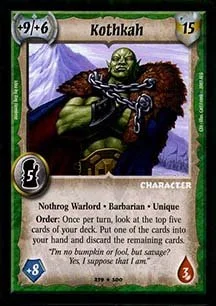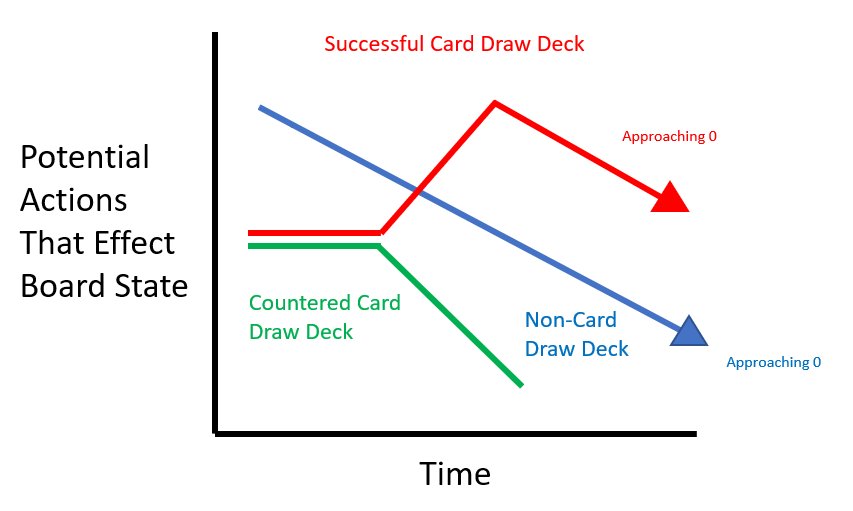Warlord Deckbuilding: Counterdraw
/Has this ever happened to you? You sit down to play a game of Warlord. You’re swinging at your opponent’s Gundas, but your opponent isn’t swinging back. They’re diving through their deck with Carg’rags, Sethusks, Loyalty’s Rewards and Kothkah’s ability. They keep throwing up big bodies and you’re running out of strikes. They still have five cards in their hand—you’re out. Suddenly, you find yourself looking at a Koratcghuk with The King’s Lady, standing right behind a Sar’ean. Your Warlord is in the 3rd rank, alone, and THUMP: you’re dead.
Deckbuilding with Intent
the smuggest nothrog in lukkot
Any time you’re building a deck, you need to ask yourself three questions:
- How am I going to win the game?
- How is my opponent going to stop me from winning the game?
- How can I stop them from stopping me from winning the game?
The simplest possible way to answer all these questions is to play the most aggressive deck with the most strikes possible. How do you win? You kill your opponents’ characters as quickly as possible. How will they stop you? They’ll play hard to kill characters or kill your strikers before they can swing. How do you stop that? You make sure your swings are harder, faster, and more efficient. While this sort of deck is great in theory, it’s much harder in practice, when a single Shadowreaver can frequently shut things down. Most of the time, with most decks, you’ll need to engage with these questions a little more carefully.
These questions can also be answered in the same generic way: I’m going to win with specific cards. My opponent will try to stop me with specific cards. I’ll counter my opponent’s tricks with other specific cards. The problem here is that for this to work, you need to have those specific cards in your hand. In Warlord, you’re only guaranteed to see five cards a turn, which isn’t great odds to see everything you need. Your tools to see those key cards are redundancy and card draw. Redundancy works well for generic effects: Fiery Bolts and Final Power are both pretty good for generating strikes. But you’re not going to find another card that works in basically the same way as Davaenus. If you really need specific, individual cards, card draw is the way to go. Check out this Introduction to Card Draw for a more detailed analysis of drawing the cards you need.
Every time you build a deck, you’re dealing with a limited number of slots, and only so many you can dedicate to any cards that aren’t actively winning the game. Most decks will run cards that draw while also doing something else: Carg’rag and The Lost Bride provide you with a body, From Dust to Dust kills an opposing character. Only decks that really want to delve deep quickly, like Uber and Combo, can spare space and actions for cards that do nothing but draw, like Loyalty’s Reward or Meet at the Inn. Unlike card draw cards, there are very few counter draw cards that do things other than counter draw. Baraz is a standout, as a character who can potentially shoot the turn he comes into play, in addition to sniping those trying to draw, but other counter-draw characters, like Rr’gent, Rollen Watts and Bek’tor Elshemeer don’t have the same innate value as their counterparts, since they don’t necessarily do anything except provide weak bodies if the opponent isn’t trying to draw.
Knowing Your Timings
So why would you devote slots to counter draw, when it doesn’t fire off your combo or jumpstart your uber, and doesn’t have another upside like card draw? Well, card draw has a weakness—card draw takes time to get going. Look at this chart: a card draw deck is going to have fewer options which will affect the board state at the beginning of the tun than a card that doesn’t run draw, because some of its cards will only be useful in drawing more cards. Once it starts drawing those cards, it’s going to have access to more options than a deck without card draw would. A deck not running card draw needs to take advantage of the period in which it has more possible actions to take actions away from the card draw deck faster than the card draw deck can produce them. If the non-drawing deck can’t do that, it’s going to be overwhelmed. You can take actions away by murdering your opponent’s characters and collapsing their ranks—you can also take actions away by removing your opponent’s ability to draw.
The speediest possible rush deck doesn’t need counter draw because it (ideally) puts itself in a winning position before that window closes. Many rush decks can’t quite get over that hump on turn one, particularly if the draw player is flooding the board with Nothrog/Elf characters who both draw and defend. These rush decks need counter draw more than any other deck. Slightly slower decks with more powerful payoffs, like Pit Fight Jodin or an A Quick Death Trespass, may be able to cut a middle path—a bit of draw to speed them up, but enough redundancy to stay competitive versus rush. If you can ignore a draw deck’s wall of bodies, you’re usually safe landing the kill on turn 2. When two combo/uber decks collide, it’s a race to get set up faster: drawing more is great, but slowing down your opponent’s draw works well, too.
Counter draw is a hedge. Each slot you devote to counter draw you’re risking a potential dead card against a deck that doesn’t run draw versus the power to turn multiple of your opponent’s cards into dead cards when you play versus a deck that does. You’re saying, “I can do what I need to with a hand of only 4 cards working towards that agenda.” But if you’ve got a deck that isn’t consistently crippling its opponents early turn 1, or consistently killing the enemy Warlord by other means by turn 2, you’ve got to plan how to either outdraw your opponent or stop them from doing it to you.
Specific Cards
“You wouldn’t deprive an old man of his walking stick?” -GANDALF the white, About to shut down behlial
When it comes to specific cards, the best forms of counter draw are repeatable, since decks that want to draw will try to do it every turn. Baraz and Staff of Secrets are the standouts here, flexible, repeatable, and versatile. Rr’gent also fits into this category, although he comes at a higher cost and with less offensive potential than either Baraz or Staff, he is much, much harder for a card draw opponent to play around. Rollen Watts, Asimon and Bektor Elshemeer are all a bit more niche, or less repeatable. Some actions counter a specific instance of draw: Burn the Inn, Twist of Fate and Ill-Gotten Gains are the most common. These cards are powerful if they go off but run a higher risk of being dead draws—they’re best in decks where your Warlord has a discard ability, to get some use out of them if you need to. Finally, there are actions that shut down draw for the entire turn: Sanctuary, Amnesia, Bascaron’s Gaze and Bascarite Swarm. The Bascarite actions are clunky and either unreliable or easy to play around. Sanctuary and Amnesia are slower paced than the one-off blocks, working at order speed rather than react speed, but they’ll reliably shut things down for a turn.
Any time you build a deck in Warlord, you need to ask yourself questions about card draw. How many slots will you devote to it? Should you dip your toe in or go full force? How will your deck deal with an opponent who’s going full force? How will you deal with someone trying to stop you from drawing? Hopefully this article will help you answer those questions!



